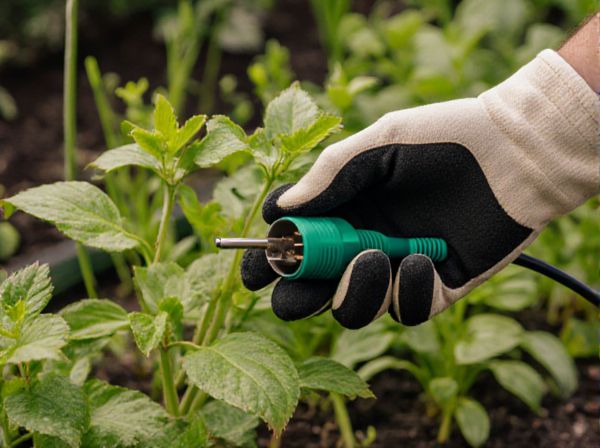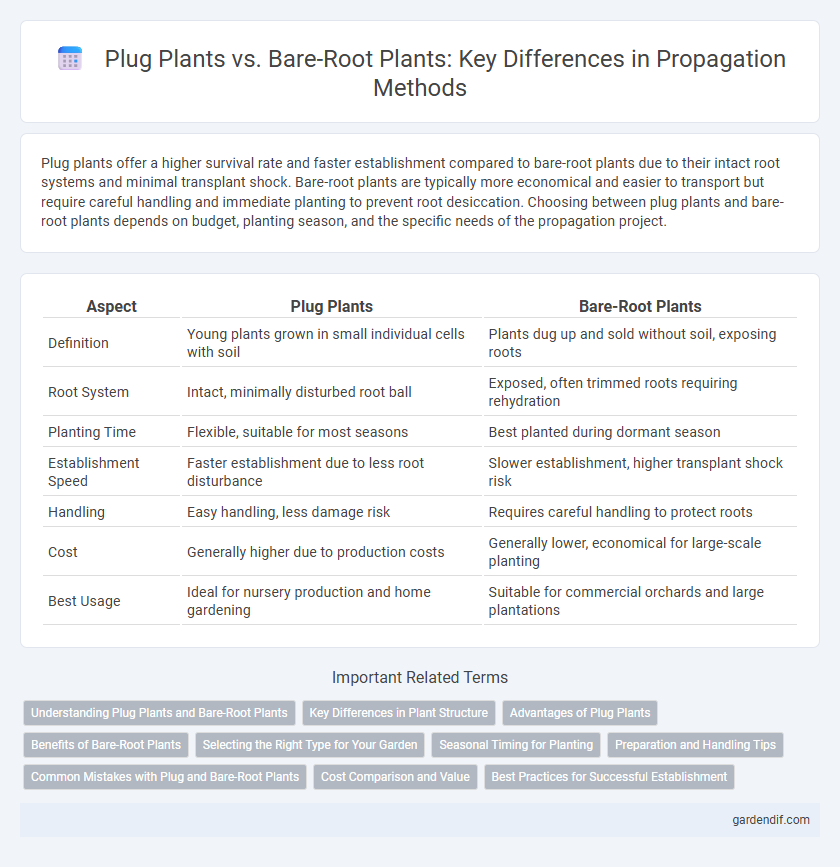
Plug plants vs bare-root plants Illustration
Plug plants offer a higher survival rate and faster establishment compared to bare-root plants due to their intact root systems and minimal transplant shock. Bare-root plants are typically more economical and easier to transport but require careful handling and immediate planting to prevent root desiccation. Choosing between plug plants and bare-root plants depends on budget, planting season, and the specific needs of the propagation project.
Table of Comparison
| Aspect | Plug Plants | Bare-Root Plants |
|---|---|---|
| Definition | Young plants grown in small individual cells with soil | Plants dug up and sold without soil, exposing roots |
| Root System | Intact, minimally disturbed root ball | Exposed, often trimmed roots requiring rehydration |
| Planting Time | Flexible, suitable for most seasons | Best planted during dormant season |
| Establishment Speed | Faster establishment due to less root disturbance | Slower establishment, higher transplant shock risk |
| Handling | Easy handling, less damage risk | Requires careful handling to protect roots |
| Cost | Generally higher due to production costs | Generally lower, economical for large-scale planting |
| Best Usage | Ideal for nursery production and home gardening | Suitable for commercial orchards and large plantations |
Understanding Plug Plants and Bare-Root Plants
Plug plants are young, container-grown seedlings cultivated in trays with individual cells, promoting strong root development and reducing transplant shock. Bare-root plants are dormant, root-only stock typically lifted from the soil without soil clinging to the roots, making them lightweight and easier to transport. Understanding the differences helps in selecting the appropriate propagation method for improved plant establishment and growth success.
Key Differences in Plant Structure
Plug plants feature a compact root ball and developed foliage, enabling easier handling and faster establishment in the garden. Bare-root plants, lacking soil around their roots, have exposed root systems that require careful soaking before planting to prevent dehydration. This structural variation impacts transplant shock risk and initial growth speed, with plug plants generally providing a sturdier start due to their established root-soil contact.
Advantages of Plug Plants
Plug plants offer several advantages over bare-root plants, including higher survival rates due to their established root systems and reduced transplant shock. Their compact size allows for easier handling and more uniform planting, which promotes faster growth and earlier harvests. Moreover, plug plants often exhibit improved disease resistance, enhancing overall crop quality and yield.
Benefits of Bare-Root Plants
Bare-root plants offer significant advantages including lower cost and easier transportation due to the absence of soil around the roots, which reduces weight and bulk. Their exposed roots allow for more effective examination and pruning, enhancing root health and establishment upon planting. These plants generally establish faster in the ground compared to plug plants, promoting quicker growth and earlier fruiting or flowering.
Selecting the Right Type for Your Garden
Choosing between plug plants and bare-root plants depends on garden conditions and plant species. Plug plants offer robust root systems and faster establishment, making them ideal for early planting and high survival rates. Bare-root plants are cost-effective and suitable for dormant seasons, requiring careful handling to prevent root damage and ensure successful growth.
Seasonal Timing for Planting
Plug plants are ideal for planting in early spring or late summer when soil temperatures are moderate, promoting rapid root establishment and reducing transplant shock. Bare-root plants are best planted during their dormant season, typically late fall to early spring, to ensure roots remain moist and undamaged before active growth begins. Timing planting according to each type's optimal season enhances survival rates and overall plant vigor.
Preparation and Handling Tips
Plug plants require careful hydration before planting to prevent transplant shock, while bare-root plants need thorough soaking to rehydrate roots effectively. Both types benefit from gentle handling to avoid root damage, with bare-root plants demanding extra caution due to exposed root systems. Proper soil preparation, including loosening and moistening, enhances root establishment and overall propagation success for each plant type.
Common Mistakes with Plug and Bare-Root Plants
Common mistakes with plug plants include overwatering, leading to root rot, and failing to harden them off before transplanting. Bare-root plants often suffer from drying out during storage or planting delays, which reduces survival rates and growth performance. Neglecting proper planting depth and timing in both plug and bare-root plants can cause stunted growth and increased transplant shock.
Cost Comparison and Value
Plug plants typically incur higher initial costs than bare-root plants due to nursery production and packaging expenses. Bare-root plants offer a cost-effective option with reduced shipping and handling fees, making them advantageous for large-scale propagation projects. Value assessment favors plug plants for faster establishment and lower mortality rates, which can offset higher upfront costs over time.
Best Practices for Successful Establishment
Plug plants offer a higher survival rate due to their developed root systems and minimal transplant shock compared to bare-root plants, which require careful handling to prevent root desiccation. Ensuring adequate soil moisture, proper planting depth, and immediate transplanting are critical for bare-root plants to establish successfully. Employing mulch and regular watering supports root development in both types, optimizing growth and plant health during establishment.
Plug plants vs bare-root plants Infographic

 gardendif.com
gardendif.com